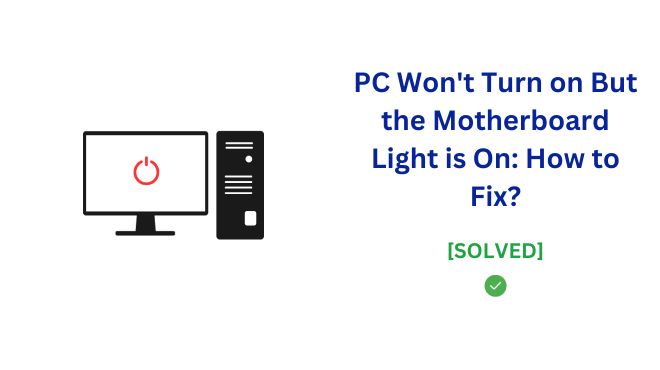Have you ever pressed the power button on your computer only to have nothing happen? No fans spinning, no lights turning on, just a PC that refuses to start. But then you notice a tiny light on the motherboard glowing. This indicates some power is making it to the system.
This problem usually happens when there are issues with your power supply and to fix this, you can try checking your PSU cables, power Cycling PC, re-installing RAM and Re-installing CMOS battery.

In this post, I’ll provide step-by-step DIY troubleshooting tips to diagnose and fix a PC that won’t turn on when you press the power button, but still shows a motherboard light. By walking through these simple checks and fixes, you can isolate what’s preventing your PC from booting and determine if it’s something you can resolve on your own.
Check Power Supply Cables are Connected
The first thing to check is whether all the power supply cables are properly connected from your PSU to the motherboard and components. Over time, cables can work loose which breaks the vital power transfer.
- Make sure the main 24-pin ATX power cable is firmly inserted into the motherboard socket.
- Check that the 4-pin or 8-pin CPU power cable is securely attached.
- Verify the SATA cables are snugly plugged into each hard drive and SSD.
If you find any loose cables, press them back into their sockets. Simply reseating cables may fix your no boot issue.
Also try using a different wall outlet, as an actual problem with that socket could prevent sufficient power delivery.
In addition, an older PSU that’s been used for years might not provide stable, clean power to the motherboard anymore. Replacing an aged unit can provide a fix.
Power Cycle the Computer
Power cycling does a hard reset which can resolve glitches stopping normal boot. Here’s how:
- Unplug the power cord and all other cables from the back of the PC.
- Press and hold the power button on the front case for 30 seconds. This drains leftover electricity.
- Wait at least 3 minutes before reconnecting the cables.
- Plug the power cord back in and press the power button to turn on the computer.
This full power cycle sequence forces a cold reboot and will restart many PCs that fail to boot normally. The long power button press followed by a waiting period clears any residual power.
Check and Reseat the RAM
Issues with the installation of the RAM memory modules can prevent successful booting.
- Always unplug the PC before opening the case to avoid static discharge dangers.
- Refer to your motherboard manual for proper handling of the RAM sticks.
Remove the RAM modules and try turning on the computer.
- If there are no beep codes when you power on without the RAM, this indicates the memory needs to be reseated.
- Insert the RAM back into the correct motherboard slots. Press down firmly until the retention clips click into place.
- Turn on the PC again to see if reseating the RAM resolved the no boot issue.
If the system now powers on normally, the problem was a temporary glitch with the memory modules. But if it still fails to boot, the RAM itself may be faulty and need replacement.
Re-install the CMOS Battery
The small CMOS battery on the motherboard provides backup power to store BIOS settings like the clock. If this battery runs down, settings can get wiped.
- Locate the battery on the motherboard, often near the RAM slots.
- Remove the CMOS battery, wait 3 minutes, then reinsert it.
- If the PC now starts up fine, you’ve fixed the issue!
- If it still doesn’t boot, the CMOS battery may need replacing.
This simple re-installation can reboot a computer that fails to power on due to CMOS battery failure.
When to Seek Professional Repair
If you’ve tried all of the troubleshooting tips above and your PC still fails to boot properly, the problem is likely a hardware failure.
- If the issue persists after reseating connections, power cycling, reseating the RAM, and replacing the CMOS battery, the motherboard or power supply may be malfunctioning.
- At this point, professional computer repair is recommended to test components and accurately determine the fault.
Seeking out a qualified technician can get your system back up and running optimally. They have the advanced tools and expertise to diagnose issues you can’t fix yourself.
Conclusion
Troubleshooting a computer that won’t boot but shows motherboard activity involves methodically trying fixes like:
- Checking all power connections are secure
- Power cycling the system
- Reseating the RAM
- Replacing the CMOS battery
Taking the time to isolate the failure can potentially save you money by resolving the issue yourself. However, if you determine the problem is beyond your technical skill, finding a professional repair shop is advised.
With the right knowledge, patience, and help when required, you can often diagnose and correct a seemingly “dead” PC showing limited signs of life. Don’t give up at the first sign of trouble. Carefully work through these tips before declaring your computer done for good!
